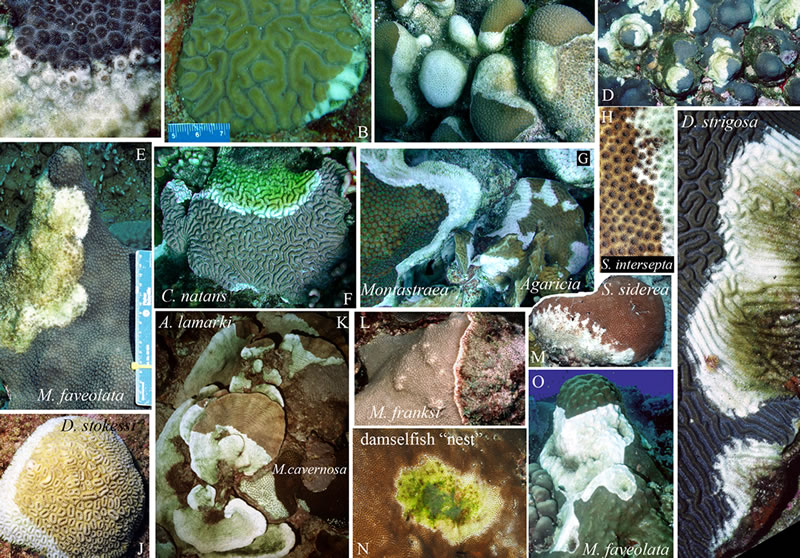 Official websites use .gov
A .gov website belongs to an official government organization in the United States. Official websites use .gov
A .gov website belongs to an official government organization in the United States. |
 Secure .gov websites use HTTPS
A lock or https:// means you’ve safely connected to the .gov website. Share sensitive information only on official, secure websites. Secure .gov websites use HTTPS
A lock or https:// means you’ve safely connected to the .gov website. Share sensitive information only on official, secure websites. |
Solutions today for reefs tomorrow
Home » Coral Disease » Characterized Diseases » Non-Acroporid White Syndromes
General Diagnostics: Focal, multifocal and coalescing lesions with a linear margin. Linear or annular tissue loss initiating at the base or perimeter of a colony, or from the margin of an old lesion and progressing as a front 1mm to 10cm/day. No distinctive pigmented band or mat, tissue discoloration, or skeletal damage. Snails and fireworms may be present.

White Plague (WP)
A distinct band of white, tissue-denuded skeleton separates healthy tissue from algalcolonized skeleton. May initiate at the colony margin (A-B) or from a previously killed portion of a colony (C) and radiate out in an irregular to annular pattern (D). A narrow band of white skeleton adjacent to colonized skeleton is indicative of slow spread (E, F, L; “Type I”) while a large band up to 10 cm or more in width indicates rapid spread (G,K,I,O; “Type II”). Lesion margin may be irregular (H), serpiginous (M), or annular (I, J, O). Individual portions of the band may advance at different rates. WP advances from one coral to adjacent colonies. Affects at least 42 species of corals.

White Syndrome (WS)
Uncharacterized lesions with diffuse patterns of tissue loss; focal, multifocal coalescing; may have linear, or annular margins, with a sharp demarcation between normal tissue and bare skeleton. Irregular lesions on Agaricia (G) are shown.
Damselfish Lesions
Fish territories occur among corals; bite marks denude tissue in a focal or multifocal pattern (N). Lesions may progressively expand in annular manner, and new lesions appear in other locations.
Snail predation
Aggregates of snails may remove tissue in a focal or annular pattern; snails may be on the lesion or at the perimeter of the colony. Parrotfish predation may result in multiple small focal or multifocal lesions and larger annular bands that progressively expand in size; these have tissue loss and skeletal damage.
Bleaching-Associated Mortality
The CDHC is a network of scientists, managers, and agency representatives devoted to understanding coral health and disease.
Funding support provided by NOAA CRCP
Web hosting by NOAA NCCOS
Coral Disease and Health Consortium
Hollings Marine Laboratory
331 Fort Johnson Road
Charleston, SC 29412 USA
Email: cdhc.coral@noaa.gov